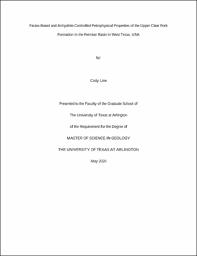
ATTENTION: The works hosted here are being migrated to a new repository that will consolidate resources, improve discoverability, and better show UTA's research impact on the global community. We will update authors as the migration progresses. Please see MavMatrix for more information.
Show simple item record
| dc.contributor.advisor | Hu, Max | |
| dc.creator | Line, Cody A | |
| dc.date.accessioned | 2020-06-15T13:40:28Z | |
| dc.date.available | 2020-06-15T13:40:28Z | |
| dc.date.created | 2020-05 | |
| dc.date.issued | 2020-05-13 | |
| dc.date.submitted | May 2020 | |
| dc.identifier.uri | http://hdl.handle.net/10106/29119 | |
| dc.description.abstract | The Leonardian-aged dolomite of the upper Clear Fork Formation in the Palm Sunday field of West Texas exhibits a wide range of facies that vary during deposition due to environmental factors such as water depth, wave energy, salinity, and oxygen availability. Variations in facies and associated mineralogy play a role on the petrophysical characteristics such as porosity, permeability, and water absorption.
This study intends to provide a better understanding on the petrophysical properties of the upper Clear Fork by facies type. Seven core samples with different facies from two wells in the Palm Sunday field were tested to determine how the pore structure of each facies will affect fluid flow and hydrocarbon production. Laboratory experiments included x-ray diffraction (XRD) for minerology, TOC, pyrolysis, vacuum saturation for porosity, mercury intrusion capillary pressure (MICP) for pore structure characteristics, and imbibition and vapor absorption for fluid flow behavior; in addition vacuum saturation, liquid pycnometry, and imbibition-vapor absorption tests used two different fluids of hydrophilic and hydrophobic characteristics. XRD analyses indicate all samples are composed of predominately dolomite and anhydrite with a minimal quartz content. Results show that all samples are organic-lean with TOC ranging from 0.04-0.51%. The sample taken from the massive carbonaceous mudstone facies exhibits the highest porosity at ~4% from both MICP and vacuum saturation, while the porosity from the other samples range from 0.24-3.57%. Dominant pore types from all samples are determined to be probably intergranular pores from MICP analyses with most pore-throat diameters in the 0.1-10 µm range. Low pore connectivity for most samples is determined from fluid imbibition. Well log analysis was performed to create curves for porosity, permeability, and water saturation. Porosity values from well log analyses match well with core analysis, however permeability and water saturation did not match as well. | |
| dc.format.mimetype | application/pdf | |
| dc.language.iso | en_US | |
| dc.subject | Clear Fork | |
| dc.subject | anhydrite | |
| dc.subject | upper | |
| dc.title | Facies-Based and Anhydrite-Controlled Petrophysical Properties of the upper Clear Fork Formation in the Permian Basin in West Texas, USA | |
| dc.type | Thesis | |
| dc.degree.department | Earth and Environmental Sciences | |
| dc.degree.name | Master of Science in Earth and Environmental Science | |
| dc.date.updated | 2020-06-15T13:40:31Z | |
| thesis.degree.department | Earth and Environmental Sciences | |
| thesis.degree.grantor | The University of Texas at Arlington | |
| thesis.degree.level | Masters | |
| thesis.degree.name | Master of Science in Earth and Environmental Science | |
| dc.type.material | text | |
| dc.creator.orcid | 0000-0001-9999-9114 | |
Files in this item
- Name:
- LINE-THESIS-2020.pdf
- Size:
- 4.575Mb
- Format:
- PDF
This item appears in the following Collection(s)
Show simple item record


